|
WHY THE LONG FACE?
The rights and wrongs of Space Giraffe
Making the same
two or three videogames over and over again for 20-odd years can
lead developers in one of two directions. (Actually, three if you
count the Metal Slug option of "make every game exactly the same as
the last one". Or four if you go the Frogger route of simply whoring
out your brand IP to anyone who gives you a cheque. But for the sake
of this particular argument, we'll stick to the main two.) Choose
the easier of the two paths and your games will constantly reach out
to an ever-widening audience, innovating and developing the gameplay
while still remaining accessible to the uninitiated - or even, in an
ideal world, getting MORE accessible and popular with each
successive release.
Indeed,
sometimes it's even possible to make things almost TOO accessible,
as in the case of the
Burnout series. Criterion's high-octane racing
line has evolved into something that's barely recognisable from the
debut title (which, implausible as it might seem to anyone who's
played the more recent versions, was actually about AVOIDING
collisions), and been dumbed down so much along the way that a
one-armed gorilla could clear about 60% of it just by being trained
to keep his big hairy hand gripped around the accelerator trigger.
Not unrelatedly,
each new Burnout sells more than the last. But if you're concerned
with things more important than mere money-grubbing, taking the
conceptual high ground in the name of art is fraught with danger
too. In that scenario, you can all too easily end up with something
like the Street Fighter or Virtua Fighter series, endlessly refined
and tweaked for the benefit of insanely hardcore fans until you get
a game so spectacularly impenetrable to unsuspecting newcomers that
the instructions might as well be written in ancient Phoenician,
full of absurd nonsense about "Z-ism" and reversed air
counter-tackle returning stumble throw blocks, until normal people
run away crying and you're left with an audience of about nine
completely socially-dysfunctional autistic savants in Tokyo.
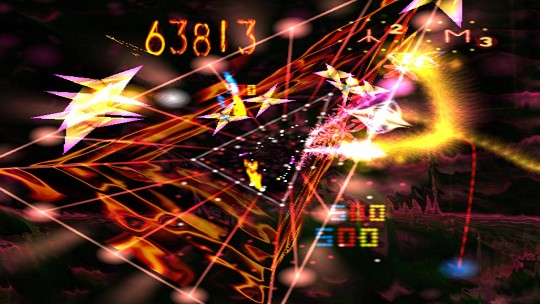
Most of the screenshots
which will appear in this feature are hugely misleading.
Trying to
reconcile the conflicting demands of the iterative sequel, then, is
a difficult task, and nobody embodies the challenges of this very
particular situation better than goat-loving 80s bedroom-coding poster-hippy
Jeff Minter. Pretty much everything the one-man Llamasoft developer
has created since 1990 has been a variant of either Defender,
Centipede or Tempest, and it's a gameography which, as alert WoS
viewers will already be well aware, spans the fullest possible
spectrum of success and failure. At one end sit stunning triumphs
like the magnificent
Tempest 2000
and the superb independent release
Gridrunner++,
while at the other lurk wretched atrocities like
Defender 2000
and Tempest 3000.
Even within the
confines of a single design, therefore, we've seen that it's
possible for the same person to get the formula both spectacularly
right and hideously wrong. So when it was announced a year or so ago
that Llamasoft was to produce "Space Giraffe", another new take on
Tempest for Xbox Live Arcade, fans of the super-intense
single-screen shooter series tried to calm their racing heartbeats and held
their breath to see which way the space cookie would crumble. And
any minute now, impatient viewers will be relieved to hear, we're
going to get to the end of this seemingly-unnecessary preamble and
find out.
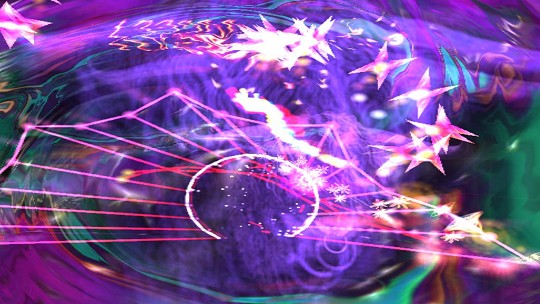
These first two, for
example, suggest a relatively easy-to-discern Tempesty game field.
Right off the
bat, though, the game appears to throw a spaniel into the works by
announcing in the very first line of its play instructions that "Space
Giraffe is not Tempest!" and spends much of manual
emphasising the various differences between the two superficially
similar games. There are in fact just two major fundamental changes
to the Tempest gameplay model, but they're both highly significant.
The first one - directional firing - alters the basic nature of
Tempest, by removing all meaning from the grid lines that separate
each level's web into channels. Once dividing the playfield into
discrete segments which most enemies and all bullets were unable to
traverse, the channels are now mere decoration. Both the player and
his enemies can shoot diagonally across the channels as well as
directly down them, and almost every protagonist can and does move freely
across the web.
If Space Giraffe
really wanted to set itself free from the shackles of Tempest
comparisons, it would have done well to dispense with the grid
lines, and the only purpose of leaving them in seems to have been to
draw in fans of the existing titles who might be more wary of a
totally unfamiliar design. However, the other big gameplay change
does perform the task which the graphic design shirks, and turns SG
into something with a very distinct feel of its own by dispensing
with the central danger mechanic of every previous Tempest game.
Since Dave
Theurer's original 1980 arcade machine, the biggest threat to the
Tempest player has been enemies who ascend to the outer rim of the
web, and by doing so become practically invulnerable. With no means
of shooting to the side, the player was reduced to last-resort
measures like firing his Superzapper smart bomb or (in the case of
T2K), scrambling to collect the "jump" powerup on each stage and
then spending most of the level pogoing like a punk rock
jack-in-the-box to stay away from rim-riding baddies, missing out on
valuable powerups in the process and turning the game into a bit of
a lottery. Tempest 3000's partially-homing shots were a badly flawed
attempt at keeping things more sensible when enemies reached the
upper edge of the grid, but Space Giraffe finally gets it right.
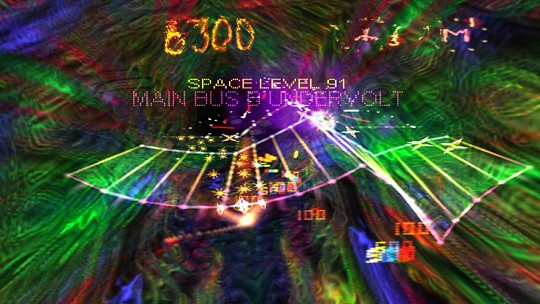
Static images, however, do a very poor job of
conveying how chaotic the game looks in play.
As you shoot
things in Space Giraffe, you extend your "Power Zone", a brighter
area of the web which extends from the player's edge of the grid
down towards the bottom, and shrinks back towards the player when no
enemies are being destroyed or power-ups collected. As long as the
Power Zone is greater than zero, almost every type of enemy can be
rammed (or "bulled", in the game's idiolect) off the rim. As well as
altering the threat balance, "bulling" also changes the focus of the
scoring, because if you knock a large number of enemies off the edge
at once, you also increase your score multiplier up to a maximum of
9x. Not only does this revolutionise the basic character of Tempest
- now enemies reaching the rim is a welcome event to be actively
sought and exploited, not a deadly one - but it provides one of the
most rewarding gameplay functions in recent memory.
Bulling off a
huge clutch of baddies in one go, accompanied by the evocative
dive-bomber scream of a Star Wars TIE Fighter and the smashed
enemies spinning balletically up into the air, feels so
astonishingly good that you'll deliberately play yourself into
dangerous situations just to get the big narcotic adrenaline hit
again, and that risk-versus-reward mechanic is at the heart of all
of the best arcade games. It's a genius piece of re-imagining, and
practically justifies the absurdly low purchase price of Space
Giraffe by itself.
In isolation, of
course, bulling would make the game incredibly easy. Rebalancing the
gameplay after such a radical modification to its core structure is
no simple task, and it's here that SG first falls down a little, resorting
to several rather cheap methods to counter the player's considerable
new-found power. The most immediately obvious culprits, and the
factor which will probably do the most to scare off new players
instantly, are the graphics.
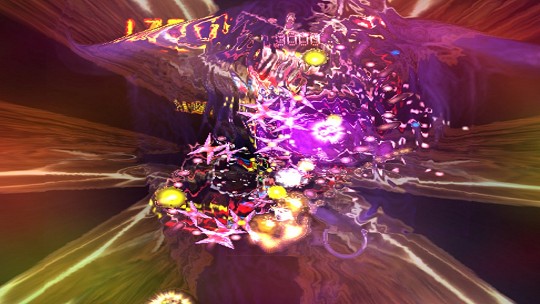
For a very considerable
percentage of the time, you'll be dealing with something more like
this.
Graphically,
Space Giraffe is frankly terrifying. On first play, and for a
considerable time afterwards, it seems simply impossible to make any
sense out of what's happening on your screen. The reason for this is
that the game is built on the engine of the 360's built-in music
visualiser Neon (also coded by Minter), and the grid-blasting action
is superimposed directly onto the visualiser in maximum psychedelic
tripout mode. It's an absolute maelstrom of sensory overload which
makes even the most extreme mayhem of Geometry Wars: Retro Evolved
look like a faded old newspaper picture of Pong, and for a great
many players the demo alone will be enough to leave them whimpering
in a corner. (In which case it's probably just as well, as the later
stages would be likely to cause a major psychotic episode.)
The initial onslaught on the eyeballs is
frightening, but after a brief period of acclimatisation, helped by
a non-compulsory but useful tutorial and some gentle opening levels
on which to practice your new skills, the game starts to make sense.
As soon as it does, however, it whips the rug out from under the
player's feet again with some nasty tricks. The worst of the early
ones - in fact, probably the worst throughout the game - is the
appearance of the Flowers. On first appearance a direct steal from
the Spikers in Tempest, they grow up a single channel towards the
player, and can (usually) be hammered back down with bullets. If
left unmolested, they either explode, sending an indestructible
daisy-like head up the channel, or grow all the way past the outer
edge of the web, the long green stalk presenting an impassable
obstacle to the Giraffe's movement until they either explode, are
destroyed with a smart bomb, or are jumped over using one of the
player's single-use jump pods.
While the
Flowers are inherently annoying, that's not the actual problem with
them - after all, enemies are supposed to be annoying,
because their entire purpose is to kill you. The clue is in the word
"usually" in the previous paragraph. The trouble with Flowers is that
like real flowers, they come in various types, some more dangerous
than others. Some are very easy to shoot
down to a manageable size with your bullets, some are much more
resistant to your fire, and some are completely impervious,
shrugging off even a smart-bomb attack without the slightest
impediment to their growth up the web. But unlike real flowers, there are no visual
differences between the numerous varieties to warn you which are the
dangerous ones, and having
identical-looking enemies with very significantly different
characteristics is such a glaring piece of empirically terrible
basic game design that it's a complete mystery how it was ever
allowed to get past the playtesters and QA and make it into the
finished product.
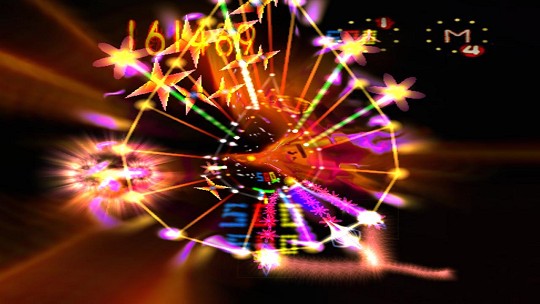
An early wave infested
with past-the-rim Flowers.
Aside from the
Flowers, the game's roster of enemies is pretty well-judged,
abandoning the over-complicated excesses of Tempest 3000 for a
tighter line-up, although far too many of them appear with no
introduction. There's no excuse for not including a couple of lines
of basic info on each enemy type in the instructions, leaving the player
to either try to work out some fairly arcane behavioural rules from
amid the game's visual turmoil or hunt around on the internet for an
FAQ. Dealing with the your adversaries is supposed to be the
challenge of a videogame, not working out that (for some unexplained
reason) they're invulnerable to bullets unless they're moving
sideways. However, it's still better to have to figure out a couple
of undocumented enemy types than remember what to do about 17
different ones.
There is
one particularly unwelcome reappearance from the cast of the Nuon
game, though, in the form of the Rotor, a cheap and lazy enemy which
spins the web around and effectively reverses your controls like a
bad Amiga platformer from 1994. In a game where the player's
beleaguered orientation perception already has to contend with webs
in spiral shapes, webs with twisting corkscrew channels and webs
where you're at the bottom end of a conical shape and are
effectively playing "inside-out" - in addition to having to get your
head around this geometry for twice as many elements as before (your
directional firing as well as movement) - also having to suffer an
enemy which effectively makes right left and vice versa several
times in a level is a smug little prank that's barely short of
cheating.
The enemies do
perhaps also suffer from looking slightly too similar to each other,
all being constructed from a fairly small set of elements (circles,
Xs and asterisks), but there are surprisingly few instances of
mistaking one for another, partly thanks to the different sounds
they make but mostly due to the way you have to play the game, of
which more later.
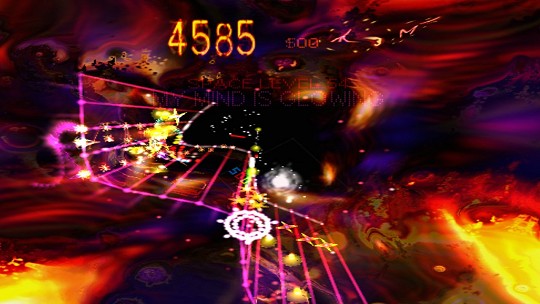
Long webs try to
tempt you to go bulling riskily into unseen territory.
Yak-lovers will
be pleased to hear that Space Giraffe's more iniquitous baddies are
outnumbered by the good ones, however. Your reviewer's personal
favourites are the laser platforms which appear somewhere around
halfway through the game's 100 levels, patrolling above the web out
of the player's reach and unleashing deadly beams at regular
intervals, signified by an audible alarm preceding a tremendous
deep, fizzing electrical hum as they fire. (Older viewers will
recognise them as descendants of the laser guns in Gridrunner, an
early Minter 8-bit title.) They're so fearsome it seems odd to call
them a "favourite", but there's nothing wrong with having terrifying
villains as long as
they're also fair ones, and the clear aural signals means you'll
only ever have yourself to blame for laser-induced deaths.
Sound cues are
one of the areas in which SG marks a major improvement from T3K, and
following them is an absolutely vital component in learning to play
the game - most of the time, in fact, you'll hear enemies before you
see them. (In general the game is a sonic masterpiece, with superb
music in the vein of the previous Tempests backing up a liberal
sprinkling of well-chosen samples and FX borrowed from the classic
Eugene Jarvis coin-ops of the early 1980s in a mix that's at once
cacophonous and yet never less than clear.)
Pleasingly, the
levels themselves are another area where SG borrows some broken
ideas from Tempest 3000 and fixes them, to excellent effect. The
simple concept of making webs be different shapes and/or sizes at
either end creates some incredibly striking and beautiful forms, and
having them flex and move in play works on the 360's smooth
high-definition display in a way that it didn't on the fuzzy,
low-framerate screen of the Nuon game. There are a couple of
lowpoints again encoring from T3K, such as grids which appear to be
complete loops but arbitrarily aren't, but such unfair chicanery is
much rarer in Space Giraffe than it was in its predecessor. (And
also doesn't appear until much further into the game, so most
players probably won't ever have to worry about it anyway.)
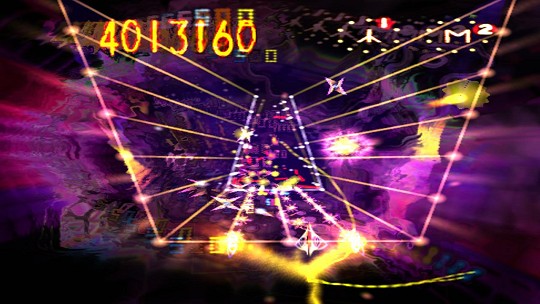
This
is the first level in which you have to seriously hone the deadly
art of bullet-juggling.
And that brings
us to the elephant in the zookeeper's lounge where Space Giraffe is
concerned, because pretty much everyone who plays this game is going
to have the same initial reaction - "You can't see what's going
on!" And indeed, you can't. (A disturbingly large amount of
the time, it's pretty hard to even keep track of where your own
Giraffe is.) In an attempt at pre-empting
such criticism before the game was even released, the developer huffily
insisted that every single enemy was visible and audible, and
therefore nobody had any excuse for claiming that they'd been killed
by something they couldn't see. However, there's a big difference
between being able to see every enemy and being able to see
all the enemies. Your reporter has completed almost 80% of
the game at the time of writing this feature, has a moderately
respectable highscore of 126 million (107th out of about 10,000 on
the global leaderboard), and yet could still only claim to have accurately identified the
cause of about one in ten - at the most - of his Giraffe's deaths. The idea that
every single danger can be seen and identified before it kills you
is technically true, but highly disingenuous.
Collective
action is your adversaries' secret. Whether enemies are discernible
in isolation or not, the game is so overwhelming that it just isn't
humanly possibly to consciously observe or track all of them. Most
of the time you'll be focused on one small part of a grid, trying to
stay alive, fend off bullets or build up your Power Zone in
readiness for a bit of bulling, and suddenly looking over at the
other side of the web to see a Flower landing or spot a Boffin
starting to fire diagonally would simply get you obliterated in a
fraction of a second.
Key to your
survival, then, is observing things unconsciously. Tempest
players often speak of it being a "zone" game, one where you have to
feel danger rather than see it, or more picturesquely of
"using the Force", but what you actually have to employ in
situations like those presented in SG is a mixture of subconscious
reasoning and peripheral perception.
Even though you
don't have time to process the game's avalanche of visual and aural
information, it's still there in your brain - you simply have to
trust your brain to accept it and act on it without verifying it
with your conscious mind first. If you're travelling to the left,
firing behind you as you go, and you hear the distinctive sound of
your bullets hitting a flower, then if you're heading back to the
right a couple of seconds later, your brain knows that there's a
flower there somewhere, and you'll have an instinct to be
cautious even if you can't actually see any peril through the
pyrotechnics. As long as you don't try to overrule that instinct with
your conscious mind, you're in "the zone" and you'll stop short of
the danger.
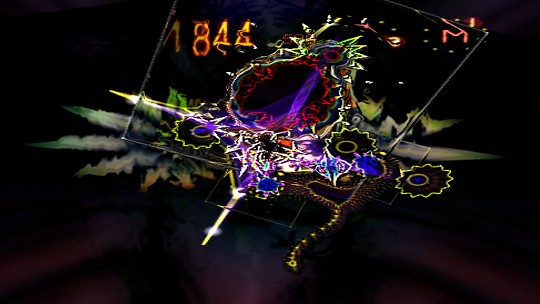
Level 64 (which
this is) can only be played in "the zone".
Regular viewers
of WoS might be mildly surprised to hear this reviewer defending a
game in which 90% of deaths are of unknown origin, but the fact is
that Tempest and similar games have always been about that kind of
gameplay - even if you don't know exactly what killed you,
you know why you got killed. And it's interesting to note
that despite the substantial alterations to the central ruleset and
the protestations of the developer, the longer you play Space
Giraffe the more like Tempest it gets. By the time you're in the
later levels, you're far too busy trying to stay alive in the
spinning, pulsing, distorted, kaleidoscopic webs to be worrying
about cultivating bulling opportunities to boost your multiplier,
and the game reverts to a frantic blast-them-before-they-blast-you
contest more akin to its ancestors.
Tallying a good
score, then, becomes about maximising your harvest in earlier
stages, using the inventive save system. As long as you finish a
level with at least three lives, you can "save" your score, which
becomes the starting bonus if you subsequently start a new game by
clearing the next level. (It makes sense in practice, honest.) At
any time, you can go back and try to improve your score on any
level, and if it's better than the saved one it becomes the new
start bonus for the next. As insignificant as this sounds, it's
actually one of the most intriguing design features of Space
Giraffe, and one which provides the game with considerably more
depth for the less-skilled player than it at first appears to have.
Real hardcore
players are catered for, appropriately enough, by the "Hardcore"
leaderboard, which only records scores from games starting all the
way back at the first level. (And they can also unlock an even
harder "Super Ox" mode too.) Gamers of more moderate ability can
still garner an impressive-looking score for the "Overall" rankings
by repeating levels over and over until they've racked up as many
points as possible, then using them as starting points to do the
same on the next level until they've maxed their way more meekly to
the end. And the klutzish can still get value for their money and a
sense of achievement by simply bludgeoning their way through the
levels one at a time, by judgement or luck, until they've beaten all
100. If you beat a level with fewer than three lives remaining
you'll be starting from 0 points each time even when you're
continuing from Level 99, so your score will be pitiful but you'll
still feel like you've bravely overcome a tough challenge, and you
will have.
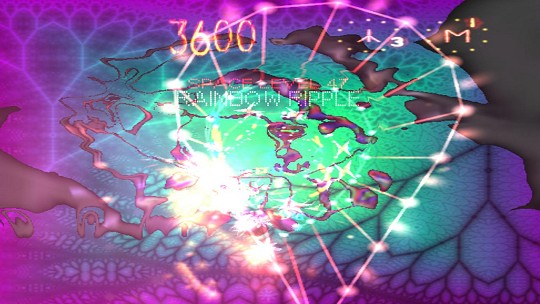
Rainbow Ripple
would be a great flavour of ice cream.
Unquestionably,
despite the above this isn't a game for everyone. Space Giraffe is
so unlike almost everything else currently in existence that it will
unfeelingly steamroller the average teenage Xbox owner from Bumhole, Idaho in
two minutes flat. But the developers deserve a lot of kudos for
offering a multiplicity of approaches to the game which ensure that
anyone who plucks up the nerve to tackle what at first seems
horrifying and impossible will get something out of it. It's a shame
that that consideration didn't extend as far as a Beginner mode
where the most extreme graphical excesses were turned off, so that
players could get a feel for the actual game mechanics before taking
on the full experience, but that's probably the price you have to
pay in 2007 for a game that's basically one person's sole and
heartfelt artistic
vision, untainted by the malign influence of focus groups and marketing clowns.
Final among the
game's praiseworthy features are the Achievements. In too many Live
Arcade games these are handed out so casually that you won't even be
aware of earning them, but SG makes you work for every point with a
varied and testing collection of challenges which add even more to
the breadth of ways you have to play the game. For example, one
Achievement requires you to beat 16 levels in a row without losing a
single life (actually monstrously difficult), while others ask you
to keep a single Flower alive throughout a level, or boost your
multiplier to 9x in a single bull run. Almost all of the
Achievements require very different approaches and styles of play,
and whether you want to play
Space Giraffe for five minutes or five hours, there's a mode in
there somewhere for you.
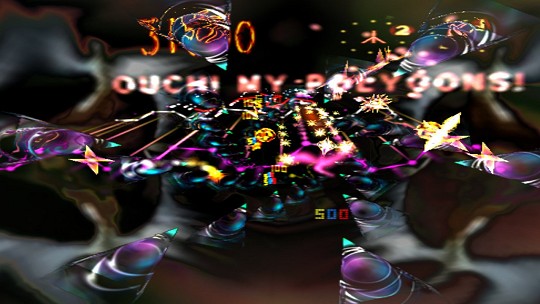
We haven't even
touched on the blizzard of jokes and cross-cultural meta-references.
At the end of
the day, the truth is that SG is an unmissable experience for anyone
with a 360. The price is so ridiculously tiny (£3.40 in UK money,
falling to as little as about £2.60 if you take advantage of current
exchange rates and buy your MS Points from the US via eBay) that
even if you only use it to freak out people who come to your house
or make your drunk friends throw up after the pub, you'll get your
money's worth. But that's damning it with faint praise. If you're
prepared to open your mind and learn a new way of playing, this is
simply a brilliant game in its own right regardless of the price.
It's easy to hate it on sight, and it's easy to give up after an
hour. And if you're unfortunate enough to have encountered them,
it's easy to be put off by the people who made it. But the game
itself doesn't deserve that fate.
Xbox Live Arcade
has been a revelation for fans of (what's rather short-sightedly and
inaccurately called) old-school gaming. As well as a lot of retro
shovelware, it's hosted some fantastic brand-new games in styles
that wouldn't have been economically viable any other way. Space
Giraffe belongs right up at the top of that list alongside Jetpac
Refuelled and Geometry Wars: Retro Evolved, but in fact it even
transcends that. Despite a few irritating, thoughtless and needless
flaws, this is one of the best games released this year at
any price, and for the sake of all of us, you owe it a chance.
|

